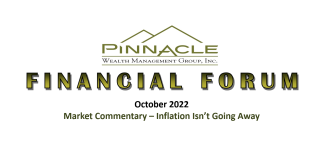
Financial Forum October 2022
Market Commentary – Inflation Isn’t Going Away
Don’t fight the Fed has been a mantra on Wall Street for about as long as there has been a Federal Reserve Bank. Over the last 15 years, that has meant that investors should be investing in risk assets (i.e., stocks, bonds, real estate, etc.) because the combination of easy money and near-zero interest rates made it nearly impossible for markets not to go up. In 2022, however, investors have learned that this mantra also works in the opposite direction, as the Federal Reserve has hiked interest rates and shrunk its balance sheet in order to combat U.S. inflation that is at a 40-year high and showing no signs of abating. This ultra-aggressive action by the Fed and other central banks has led to a bear market in equites, global bonds, as well as some commodities and foreign currencies. In other words, it’s ugly out there!
Let’s take a look at the main issues and concerns for investors and what needs to happen for markets to bottom. First up…the Fed.
FEDERAL RESERVE BANK
The Fed provided another hawkish surprise this month, as Chairman Powell made it clear that the central bank is determined to fight inflation and that a “Fed pivot” to lowering rates at the first signs of economic weakness won’t be happening anytime soon. The central bank increased its federal-funds rate target by 0.75%, or 75 basis points, to a range of 3.00% to 3.25%—the highest since early 2008. Additionally, the Fed hinted of another 1.5% of rate increases from here. That could put a fourth-straight 75 basis point hike on the table for November (just six days before the midterm elections), followed by 50 basis points in December and 25 basis points in February.
The Fed also began unloading Treasury bills and mortgage-backed securities it started amassing almost three years ago as it attempts to unwind its $9 trillion portfolio. It is currently letting $95 billion per month roll off its balance sheet.
Bottom Line: The Fed is hiking rates more than expected and at a faster rate, which increases the chances of an economic hard landing. Economic growth and 2023 earnings estimates are at risk of being lowered further. In the past few weeks, companies ranging from Walmart, FedEx, and Apple have issued sales warnings. If this continues, it increases the likelihood that the bear market has further to fall.
INFLATION
This is the root cause of our troubles. U.S. inflation rose 8.3% year-over-year in August, a 0.1% increase over July after analysts predicted inflation would fall slightly. Unlike previous months, where energy and gas prices were mainly responsible for the large increases, last month’s growth was primarily driven by food, shelter, and medical expenses, showing that core inflation is well distributed throughout the economy. Food prices posted their largest increase since May 1979, leaving consumers with less discretionary income.
The classic definition of inflation is too much money chasing too few goods. And in 2022, we have both demand (too much) and supply (too little) issues impacting prices. Usually, inflation comes from one or the other. On the demand side, there is simply too much money out there. M2 money supply was around $15.5 trillion in January 2021. It’s just under $22 trillion now and has barely declined from the highs. In other words, there’s almost 50% more money in circulation now than there was nearly two years ago. Adding to the demand side is the employment situation. Today, there are twice as many job openings (about 11.5 million) as there are people actually looking for a job (about 5.5 million). The unemployment rate is 3.6%—which is considered full employment by economists. Additionally, the Case-Shiller Home Price Index is registering nearly a 50% appreciation in home prices in just over two years.
Bottom Line: Although rates have risen sharply and the economy has lost some momentum, there is still plenty of liquidity and cash in the marketplace. The money supply has not been materially reduced by higher rates, rising unemployment, or quantitative tightening. Meanwhile, the supply chain remains challenged. Companies are still having difficulty sourcing parts and/or materials and this has resulted in less goods available for sale, thus raising prices.
For inflation to fall, we have to see either reduced demand (meaning a real slowdown that actually reduces economic demand materially) or improved supply of goods. The macroeconomic fundamentals that will result in a real drop in inflation remain elevated, and they simply aren’t declining at the pace that would see inflation fall sharply anytime soon. As Chairman Powell has stated, there is “more pain ahead” on the inflation front.
As the Fed and other central banks simultaneously raise rates to combat inflation, the biggest risk to the market moving forward is for the economy to experience a hard landing while inflation remains elevated. This is stagflation and it would have negative implications for corporate earnings and stock valuations. Higher interest rates increase costs for consumers and businesses alike, raising recession odds and negatively impacting earnings growth. A stronger U.S. dollar (thanks to our higher rates) makes U.S. multinationals’ foreign earnings worth less when translated back to dollars. Also, a higher discount rate means lower multiples assigned to those earnings, thus lowering valuations. Rest assured, we are closely monitoring the situation.
Quarterly thought…
It’s time in the market, not timing the market. Or put another way, More time = More certainty.
25 years ago, your crystal ball reveals: a Russian debt default, Long-Term Capital Management failure, the Dot Com bust, September 11 attacks, financial crisis/Great Recession, Covid pandemic, three market crashes.
Would you invest your money in stocks? If you answered “No” you missed a 10-fold return.
In the 20th Century (a 100 year period), the U.S. endured two world wars and other expensive military conflicts, the Great Depression, a dozen or so recessions, oil shocks, a flu epidemic, and the resignation of a President. Would you invest your money in stocks? If you answered “No” you would have missed the Dow rising from 66 to 11,497. Ouch!
To learn more, call our office or CLICK HERE to request a meeting today!
(734) 667-5581
Pinnacle Wealth Management Group, Inc.
www.pwmgi.com
849 Penniman Ave, Suite 201, Plymouth, MI 48170
Securities offered through Private Client Services, Member FINRA/SIPC. Advisory products and services offered through Pinnacle Wealth Management Group, Inc., a Registered Investment Advisor. Private Client Services and Pinnacle Wealth Management Group, Inc., are unaffiliated entities

